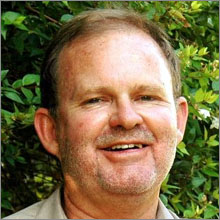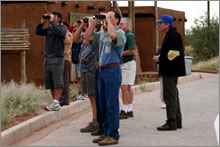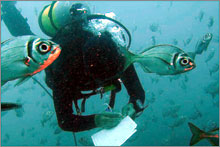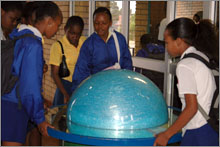SAEON's pillars become firmly entrenched for the benefit of society
|
- By Johan Pauw, Head of SAEON
The three "pillars" of the SAEON mandate - observation, information and education - are promoted throughout SAEON’s sphere of influence via a purposeful communication programme.
Some of the highlights of SAEON’s work during the past year can be summarised as follows:
Observation
The SAEON nodes are the observation and education platforms of the SAEON system. Given the complexity of negotiations with node host organisations and the many participants of a node, it should be no surprise to learn that the roll-out of a node could be a multi-year process.
In this regard, 2007 proved to be a rather successful year. We were able to replace the node manager at SAEON Ndlovu Node, accelerate SAEON Elwandle Node at a great pace, kick-start and launch the SAEON Egagasini Node by appointing a node manager, sign the hosting agreement for the SAEON Fynbos Node with SANBI and recruit its first manager, and designate the two remaining nodes and advance to the final stages of signing their respective hosting agreements. The node liaison committees of Ndlovu and Elwandle were also appointed and constituted by having their first meetings.
All the nodes have earnestly started their work by considering their mandates and domains before strategising and composing business plans and forming partnerships. Work has even started where the nodes are still in conceptualisation phase, for instance SAEON is negotiating with Drs Sue Milton and Richard Dean to systematically order their 20 years of wide-ranging Tierberg site data, whereafter the data will be made available via SAEON. This work falls within the ambit of the (soon to be established) Node for the Arid Lands.
In addition, SAEON commissioned the CSIR for the upkeep of 80 years of hydrological monitoring at Jonkershoek under mandate from the Department of Water Affairs and Forestry, since the observations were about to be disrupted due to financial constraints. This work falls within the ambit of the SAEON Fynbos Node which started up in January this year.
The three operating nodes have started collating data from relevant sources, analysing the data and placing it in the SAEON data portal. In some cases the digitisation of data has been taken on and in the case of the SAEON Egagasini Node, a firm relationship has been established with the South African Data Centre for Oceanography (SADCO) that also maintains data for the African Ocean Biogeographic Information System (Afrobis). At the SAEON Elwandle Node work has started on the compilation of a National Estuarine Database.
The SAEON Ndlovu Node obtained and digitised approximately 50 years of rainfall data for the Hans Hoheisen Research Centre, as well as vegetation, game and rainfall data from three private nature reserves. They also began the collection of metadata for the environmental monitoring data held by the Palabora Mining Company.
The Node updated the database of river flow data (obtained from the Department of Water Affairs and Forestry - DWAF) and fish deaths for all the rivers in the Kruger National Park. Data from all years (starting in the 1980s) is now combined in a single Access database. Overall, no less than 15 long-term datasets were acquired from private landowners, amateur observers and research organisations via donations made to the Node for their use and archiving.
The Node launched its first citizen science project, a long-term bird survey for the Lowveld region (including the Kruger National Park). The project is a something of an experiment for the Node, and will be used to gauge the value of "citizen science" projects as a means of environmental outreach, as well as for collecting useful data on environmental change.
The SAEON Ndlovu Node also signed a collaborative agreement with Dr Bob Scholes of the Council for Scientific and Industrial Research (CSIR) on atmospheric flux measurements in the Lowveld. In terms of the agreement SAEON provides access to certain facilities, salary support and technical assistance to the CSIR, and in return, the CSIR provides certain data and technical support to SAEON. The project will use eddy covariance technology to measure fluxes of energy as well as H2O and CO2 between the land and atmosphere at up to four locations in the Lowveld. Two sites are located within the Kruger National Park (KNP), and two outside the Park in areas of rural land use.
The SAEON Elwandle Node has developed a series of eight baseline projects for Algoa Bay, ranging from studies on the dynamics of plankton communities and coastal land-use changes to estuarine ecology and subtidal reef mapping. The node is currently advising the Council for Geoscience on priorities for the mapping of the near-shore seafloor and a joint project for the Table Mountain Marine Park is under consideration.
In collaboration with South African National Parks (SANParks) and the South African Institute for Aquatic Biodiversity (SAIAB), the node supports the data archiving and analysis for a 15-year inshore reef fish monitoring programme and a long-term monitoring programme looking at temporal change and spatial variation of offshore reef fish communities in a largely unmodified marine habitat at the Tsitsikamma National Park. It is further establishing baseline marine data and a long-term monitoring programme for the management of the Greater Addo National Park.
The original five-year target for the Elwandle Node was to concentrate on the warm-temperate region of the coast due to logistical and financial constraints. The Node has now been awarded the mandates to implement and manage the following two major programmes (one in the cool-temperate region and the other National) and has therefore exceeded its objectives by obtaining national status years ahead of schedule:
- Cool-temperate region – Table Mountain Marine Park Monitoring programme, sponsored by SANParks
- National – African Coelacanth Ecosystem Programme (ACEP), sponsored by SAIAB and the Department of Science and Technology (DST)
The Elwandle Node is currently supporting a project of Prof Charles Griffiths of the University of Cape Town (UCT) entitled ‘Long-term changes in rocky shore biota along the South African coast (1940 – 2007) with an assessment of drivers of change’, which should lead to a PhD and delivery of the data to SAEON. A combined project of the Water Research Commission (WRC), Nelson Mandela Metropolitan University (NMMU) and SAEON examining the effects of the August 2006 floods on the functioning of the Knysna and Swartvlei estuaries, has been completed. It established the present ecological state of the estuary, reviewed the implications of a number of flow reduction scenarios and predicted their biological effects.This study has already greatly contributed to another larger multi-institutional DWAF-funded study, lead by Elwandle Node, on the freshwater reserve and monitoring plan for the Knysna Estuary.
For its specialised inshore work, the SAEON Elwandle Node has been equipped with a 8m inflatable boat able to transport 12 people as well as two current meters which are likened to "underwater weather stations". The node will share this equipment with its partner organisations.
The DST recently announced that Global Change will be addressed as one of its five Grand Challenges for the ten-year period until 2018. Climate Change is seen as the most important component of Global Change and SAEON has been involved in the Department’s planning process around the Grand Challenge. Indeed, SAEON has already commissioned the University of the Witwatersrand to downscale the available regional climate change models. A user workshop has been held and the final products are expected soon.
SAEON’s infrastructure, data and information management system is foreseen to make a significant contribution to the research on the Global Change topic. Similarly, SAEON will contribute to the realisation of a South African Earth Observation System (SAEOS[1]) and the Global Earth Observation System of Systems (GEOSS). In addition, SAEON’s Egagasini and Elwandle nodes are partners in the Africa Centre for Climate and Earth System Science (ACCESS[2]) programme and its focus on ocean-atmospheric interactions and climate change.
From a policy input perspective, SAEON has engaged with the national rangeland, grassland and biodiversity (terrestrial and marine) monitoring initiatives of the Agricultural Research Council (ARC) and South African National Biodiversity Institute (SANBI), and with the ‘Marine Protected Area Management and Monitoring’ initiatives of Marine and Coastal Management (MCM).
In addition, a number of projects on defined ecosystems has been established to provide baseline data and monitoring systems and/or ecological models for determining the impact of different natural or human-induced changes. The 50 requests that were received for digitised copies of the Estuaries report series of the CSIR is yet another example of the need for research and management input that SAEON is satisfying.
SAEON’s interest in longitudinal socio-economic-demographic and health surveillance data has led to discussions with the Agincourt population health research programme with a view to multidisciplinary collaboration exploring human ecology and the impact of pandemics such as HIV-Aids on natural resource use by rural communities.
With regard to its regional focus, SAEON continued its role as chair of the Environmental Long-Term Observatories of southern Africa (ELTOSA) and organised the fifth ELTOSA Annual General Meeting and research planning workshop at the SAEON Ndlovu Node. This very productive meeting was attended by Namibia, Botswana, Malawi, Mozambique and South Africa, and led to the conceptualisation of a broad-based joint long-term research programme focused on several river basins in the Savanna Biome. SAEON will assume a leading role in the further development of the programme.
Early in 2007, UCT became one of a growing list of organisations to sign an Accession Agreement with SAEON. These agreements facilitate and order arrangements concerning the participation of affiliated persons in SAEON nodes, with specific reference to data management and sharing. SAEON is currently negotiating the same with the University of Pretoria.
As part of SAEON’s pursuit of excellence in observations science, a draft ‘Core Science Plan’ for SAEON has seen the light and met with general approval from the SAEON Technical Steering Committee. It points to several foundation projects that are required to inform and facilitate the core plan as it unfolds over time. The draft is undergoing further elaboration and will be the topic of consultative stakeholder workshops during 2008.
Observation and research processes in the field of environmental science are time consuming by nature. Although the current number of 17 research-based papers is already exceeding expectations for the financial year to date, the scene is set for a flood of SAEON-supported papers in the next year or two. Many of these will exploit existing datasets hitherto not yet analysed for their inherent contributions; nor for their contribution in conjunction with data sets from other areas, periods or disciplines.
The 2007 GEO Ministerial Summit in Cape Town was an appropriate international event to publish the landmark South African Journal of Science issue that is dedicated to a multi-disciplinary series of papers resulting from the first SAEON Summit that was held in 2006. This publication is sure to remain a benchmark in South African observation science for many decades to come and is currently being distributed free of charge to SAEON stakeholders to maximise its value.
Information
The first phase in the development of the SAEON Data Portal was completed and the basic technology for the operation proved to be functional. Good progress was made with the development of a draft data policy. Data user and data provider agreements were developed based on legislation, user requirements and SAEON partner considerations.
The SAEON Data Portal[3] provides access to the shared capacity of the CoGIS system, a collaborative project to provide an electronic platform for data sharing and spatio-analytical capability. The co-sponsors of the project are the CSIR and the Department of Minerals and Energy (DME), and both have already entered numerous data sets on the system.
Phase II of the project is aimed at developing the interoperability capacity for the CoGIS system to be linked to a variety of externally held databases. Phase II started with establishing the User Requirement Specifications of potential new participants such as Department of Environmental Affairs and Tourism (DEAT), South African National Biodiversity Institute (SANBI), Agricultural Research Council (ARC), Council for Geoscience, and ACCESS. Phase II also plans to implement metadata management for more accurate searching and retrieval of data.
With a view to instil good data management discipline and standards, SAEON approached the National Research Foundation (NRF) grants section and proposed that future proposals to the NRF should include a section setting out in detail how data management will be performed as part of the research programme as well as how and when the data will be made available. Through this SAEON hopes to raise data management to the level of importance where it belongs in the world of research. Similar requirements can already be seen in international funding programmes, to the extent that researchers are not funded if insufficient attention is paid to data management.
SAEON supported the SANBI-initiated National Biodiversity Information Management workshop which was arranged to start giving effect to SANBI’s mandate to ‘collect, collate, coordinate and disseminate biodiversity information’. As implicated above, SANBI will in future also make use of the CoGIS system.
SAEON’s involvement and support for SADCO has increased through SAEON’s increased financial contribution to the consortium on behalf of the SAEON Egagasini Node and recently SADCO signalled its intention to join in the CoGIS system partnership. In addition, SAEON participated in a DST workshop on open access to publicly funded data.
Education
The commissioning of an independent evaluation of the impact of the Education-Outreach programme of SAEON Ndlovu Node from 2004 to 2006, has been hailed as "brave" during the World Environmental Education Conference, where the report was presented. Subsequently, it stimulated an NRF-wide debate, led by the South African Agency for Science and Technology Advancement (SAASTA), on best practice for evaluation processes.
An exciting result of the education-outreach programme, which has a primary focus on science and maths educators, is that 15 of those educators wanting to improve their skills took it upon themselves to attend a SAQA-accredited environmental education course during this year’s winter school holidays, which was presented by the SA Wildlife College on location at the SAEON Ndlovu Node, but importantly, which they paid for themselves. The evaluation report commended the programme, but also raised some areas for improvement which will be addressed.
The SAEON Ndlovu Node’s Advenviro winter holiday camp was successfully repeated this year and was held at the South African Wildlife College. This activity brings meritorious learners in direct contact with scientists during the course of a week. Some of these learners have indicated that they intend to take up science as a career.
As new nodes are being established, each one appoints an education facilitator and an additional two have joined SAEON during the past few months.
The Graduate Student Network (GSN[4]) is a brilliant initiative run by postgraduate students themselves and is expanding the science world views of the participants. A highly successful gathering with high-level speakers, workshops and practical field trips was held in Cape Town in September last year, with financial and moral support from SAEON. The workshop was also attended by the three African MSc students who, with financial support from the National Ports Authority, started their studies this year at the SAEON Elwandle Node. A remarkable eleven students, of whom eight are from designated groups, are currently pursuing postgraduate work through the SAEON Elwandle Node.
A second successful Eco-informatics learnership field trip was organised and facilitated as part of SAEON’s support for the DST’s Learnership programme. The programme teaches eco-informatics skills to unemployed graduates. SAEON collaborated with the CSIR, University of the Western Cape (UWC) and the ARC on the project.
DST recently appointed SAEON as the national coordinator for the Global Learning and Observation for the Benefit of the Environment programme (GLOBE[5]), an international schools programme supported by the US government. SAEON and DST are currently negotiating the terms of reference for the implementation of GLOBE.
Communication
Whereas it seems that an organisation cannot easily over-communicate, a communication programme must be in balance with the mandate of that organisation. The right balance has a broad margin and it appears that SAEON finds itself within the right space based on comments from colleagues that show that they are well informed about SAEON from reading the electronic newsletter[6].
The previous issue of the SAEON newsletter was the sixth of 2007 and one more than in 2006. The newsletter continues to be well read by an international readership and will remain the primary way of communication with the broad stakeholder community. The newsletter does not only feature the activities of SAEON staff but also regularly publicises relevant activities of its participants.
The newsletter, as well as contributions by individual staff members and the launch of the SAEON Egagasini Node has resulted in substantial media coverage for SAEON, and this was supported at a higher level by a chapter in GEO’s coffee table publication The Full Picture[7].
Acting on a suggestion by Dr Albert van Jaarsveld, the Vice President of the NRF, a start has been made with the compilation of an illustrated book on environmental change, directed at informing decision-makers about dramatic and visible changes and advocating for sustained support of the SAEON observation system.
A portable exhibition stand was acquired for ease of use and flexibility in terms of the fair number of exhibits that SAEON has to stage. The exhibition has so far reached approximately 58 000 people.
Summary
SAEON has reached its initial objectives, has grown exponentially in 2007 and is starting to deliver substantially on its mandate. SAEON’s financial futures are reasonably secure as it has tripled its allocation from the DST over a two-year period and will double its human capacity during 2008.
There is wide-ranging recognition for the facilitatory and enabling role that SAEON is playing. Most importantly the stakeholders appreciate that SAEON is not encroaching on existing mandates but rather supports them to deliver on their objectives.
As the complexity of running SAEON increases, so does the importance of maintaining excellent relations with the stakeholders as they form the basis of the network.
[1] www.space.gov.za/space2006/SAEOS_STRATEGY.DOC
[2] www.africaclimatescience.org
[3] www.cogis.co.za/saeon/saeon-data-portal
[5] www.globe.gov
[6] www.saeon.ac.za/eNewsletter
[7] www.earthobservations.org/documents/the_full_picture.pdf
[8] www.globe.gov














